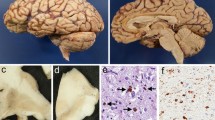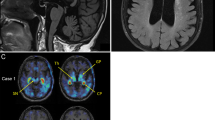Abstract
The neuropathological findings, including immunohistochemistry and electron microscopy, of two patients with clinical findings consistent with corticobasal degeneration (CBD) are reported. Both patients showed degeneration of the precentral cortex, the substantia nigra, the pallidum, and the thalamus. Many ballooned neurons were seen in the cerebral cortex, and argentophilic, skein-like inclusions suggesting neurofibrillary tangles (NFTs) were found in the brain stem and precentral cortex in patient 1. In contrast, patient 2 clearly showed NFTs in the brain stem and dentate nucleus which were indistinguishable from those seen in progressive supranuclear palsy (PSP), while only a few ballooned neurons were found in the cerebral cortex. Gallyas silver stain showed many argentophilic inclusions suggesting NFTs in the brain stem, subcortical nuclei, and cerebral cortex in both patients. Immunohistochemistry for tau showed tau-positive neurons in the cerebral cortex, brain stem, subcortical nuclei and spinal cord, and tau-positive glial cells were seen in the cerebral cortex, white matter and subcortical nuclei, and thread-like structures were seen in the cerebral cortex and white matter. Electron microscopy of the brain stem showed NFTs consisting of paired helical filaments in patient 1, and paired helical filaments and straight tubules in patient 2. Immunoelectron microscopy revealed parallel tau-positive filaments in the cerebral cortex in patent 1. From the two patients, the widespread appearance of abnormal tau and NFTs is one of the essential pathological features in CBD, and it also appears that CBD and PSP have some common underlying pathological processes. Patient 2 is closer to PSP than patient 1 and suggests CBD would link to PSP.
Similar content being viewed by others
References
Akashi T, Arima K, Maruyama N, Ando S, Inose T (1989) Severe cerebral atrophy in progressive supranuclear palsy: a case report. Clin Neuropathol 8:195–199
Arima K, Murayama S, Oyanagi S, Akashi T, Inose T (1992) Presenile dementia with progressive supranuclear palsy tangles and Pick bodies: an unusual degenerative disorder involving the cerebral cortex, cerebral nuclei, and brain stem nuclei. Acta Neuropathol 84:128–134
Bancher C, Lassmann H, Budka H, Grundke-Iqbal I, Iqbal K, Wiche G, Seitelberger F, Wisniewski HM (1987) Neurofibrillary tangles in Alzheimer's disease and progressive supranuclear palsy: antigenic similarities and differences. Microtubule-associated protein tau antigenicity is prominent in all types of tangles. Acta Neuropathol (Berl) 74:39–46
Case Records of the Massachusetts General Hospital (1985) Case 38-1985. N Engl J Med 313:739–748
Constantinidis J, Tissot R, De Ajuriaguerra J (1970) Dystonie oculo-facio-cervicale ou paralysie progressive supranucléaire de Steele-Richardson-Olszweski. Pseudo-paralysie du regard, troubles visuo-spatiaux, pseudo-démence, altérations neuronales. Rev Neurol (Paris) 122:249–262
Dickson DW, Mattiace LA (1992) Immunocytochemical studies distinguish corticobasal degeneration from progressive supranuclear palsy. J Neuropathol Exp Neurol 51:321
Dickson DW, Yen S-H, Suzuki KI, Davies P, Garcia JH, Hirano A (1986) Ballooned neurons in select neurodegenerative diseases contain phosphorylated neurofilament epitopes. Acta Neuropathol (Berl) 71:216–223
Gallyas F (1971) Silver staining of Alzheimer's neurofibrillary changes by means of physical development. Acta Morphol Acad Sci Hung 19:1–8
Giaccone G, Tagliavini F, Street JS, Ghetti B, Bugiani O (1988) Progressive supranuclear palsy with hypertrophy of the olives. An immunocytochemical study of the cytoskeleton of argyrophilic neurons. Acta Neuropathol 77:14–20
Gibb WRG, Luthert PJ, Marsden CD (1989) Corticobasal degeneration. Brain 112:1171–1192
Hauw J-J, Verny M, Delaère P, Cervera P, He Y, Duyckaerts C (1990) Constant neurofibrillary changes in the neocortex in progressive supranuclear palsy. Basic differences with Alzheimer's disease and aging. Neurosci Lett 119:182–186
Hof PR, Delacourte A, Bouras C (1992) Distribution of cortical neurofibrillary tangles in progressive supranuclear palsy: a quatitative analysis of six cases. Acta Neuropathol 84:45–51
Ihara Y (1988) Massive somatodendritic sprouting of cortical neurons in Alzheimer's disease. Brain Res 459:138–144
Lennox G, Lowe J, Morrell K, Landon M, Mayer RJ (1988) Ubiquitin is a component of neurofibrillary tangles in a variety of neurodegenerative diseases. Neurosci Lett 94: 211–217
Lippa CF, Smith TW, Fontneau N (1990) Corticonigral degeneration with neuronal achromasia: a clinicopathologic study of two cases. J Neurol Sci 98:301–310
Love S, Saitoh T, Quijada S, Cole GM, Terry RD (1988) Alz-50, ubiquitin and tau immunoreactivity of neurofibrillary tangles, Pick bodies and Lewy bodies. J Neuropathol Exp Neurol 47:393–405
Nakazato Y, Hirato J, Ishida Y, Hoshi S, Hasegawa M, Fukuda T (1990) Swollen cortical neurons in Creutzfeldt-Jakob disease contain a phosphorylated neurofilament epitope. J Neuropathol Exp Neurol 49:197–205
Nishimura M, Namba Y, Ikeda K, Oda M (1992) Glial fibrillary tangles with straight tubules in the brains of patients with progressive supranuclear palsy. Neurosci Lett 143:35–38
Nukina N, Quan Y, Nakano I, Otomo E (1992) Widespread tau abnormality in a case of corticobasal degeneration. Clin Neurol (Tokyo) 32:1093–1101 (in Japanese)
Oyanagi S (1983) Ultrastructural comparison between Pick bodies and the neurofibrillary changes in Alzheimer's disease and progressive supranuclear palsy. In: Hirano A, Miyoshi K (eds) Neuropsychiatric disorders in the elderly. Igaku-Shoin, Tokyo, pp 118–126
Paulus W, Selim M (1990) Corticonigral degeneration with neuronal achromasia and basal neurofibrillary tangles. Acta Neuorpathol 81:89–94
Pollack NJ, Mirra SS, Binder LI, Hansen LA, Wood JG (1986) Filamentous aggregates in Pick's disease, progressive supranuclear palsy, and Alzheimer's disease share antigenic determinants with microtubule-associated protein, tau. Lancet II:1211
Probst A, Langui D, Lautenschlager C, Ulrich J, Brion JP, Anderton BH (1988) Progressive supranuclear palsy: extensive neuropil threads in addition to neurofibrillary tangles. Very similar antigenicity of subcortical neuronal pathology in progressive supranuclear palsy and Alzheimer's disease. Acta Neuropathol 77:61–68
Rebeiz JJ, Kolodny EH, Richardson EP (1968) Corticodentatonigral degeneration with neuronal achromasia. Arch Neurol 18:20–33
Riley DE, Lang AE, Lewis A, Resch L, Ashby P, Hornykiewicz O, Black S (1990) Cortical-basal ganglionic degeneration. Neurology 40:1203–1212
Schmidt ML, Lee VM-Y, Hurtig LH, Trojanowski JQ (1988) Properties of antigenic determinants that distinguish neurofibrillary tangles in progressive supranuclear palsy and Alzheimer's disease. Lab Invest 59:460–466
Smith TW, Lippa CF, DeGirolami U (1992) Immunocytochemical study of ballooned neurons in cortical degeneration with neuronal achromasia. Clin Neuropathol 11:28–35
Yamada T, McGeer PL, McGeer EG (1992) Appearance of paired nucleated, tau-positive glia in patients with progressive supranuclear palsy brain tissue. Neurosci Lett 135:99–102
Yamada T, Calne DB, Akiyama H, McGeer EG, McGeer PL (1993) Further observations on Tau-positive glia in the brains with progressive supranuclear palsy. Acta Neuropathol 85: 308–315
Author information
Authors and Affiliations
Rights and permissions
About this article
Cite this article
Mori, H., Nishimura, M., Namba, Y. et al. Corticobasal degeneration: a disease with widespread appearance of abnormal tau and neurofibrillary tangles, and its relation to progressive supranuclear palsy. Acta Neuropathol 88, 113–121 (1994). https://doi.org/10.1007/BF00294503
Received:
Revised:
Accepted:
Issue Date:
DOI: https://doi.org/10.1007/BF00294503




